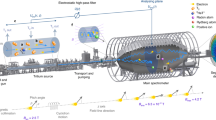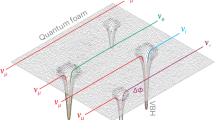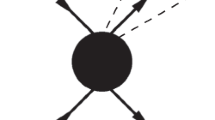Abstract
EXPERIMENTS to detect the neutrino flux from the Sun could be used to test the basic hypotheses concerning the internal constitution of the Sun and the nuclear fusion reactions believed to be occurring in its interior. The measurements of Davis, Harmer and Hoffmann1 give an upper bound on the neutrino counting rate which is approximately half of the theoretical rate calculated by Bahcall, Bahcall and Shaviv2, and an order of magnitude smaller than theoretical rates obtained by other authors. Before the discrepancy between theory and experiment can be accepted as requiring a radical change in the theory of stellar structure, it is first necessary to reduce the uncertainties and poor approximations contained in the “constitutive relations” of the theory; that is, in the equations for the nuclear reaction rates, the pressure and the opacity3, each expressed as a function of density, temperature and chemical composition of the medium. In current tables4 of solar opacity, the contribution from the scattering of radiation by free electrons is calculated under the unjustified assumption that the plasma of the solar interior can be treated as a perfect classical gas, and hence that the scattering cross-section is given simply by the classical frequency-independent Thomson cross-section Neσt, for Ne independent electrons in the plasma. This report shows that corrections to σt produced by classical5–7 and quantum6 electron correlations reduce the electron-scattering opacity in the core of the Sun by approximately one-third, and that this leads to a significant reduction in the theoretical neutrino flux.
This is a preview of subscription content, access via your institution
Access options
Subscribe to this journal
Receive 51 print issues and online access
$199.00 per year
only $3.90 per issue
Buy this article
- Purchase on Springer Link
- Instant access to full article PDF
Prices may be subject to local taxes which are calculated during checkout
Similar content being viewed by others
References
Davis, R., Harmer, D. S., and Hoffmann, K. C., Phys. Rev. Lett., 20, 1205 (1968).
Bahcall, J. N., Bahcall, N. A., and Shaviv, G., Phys. Rev. Lett., 20, 1209 (1968).
Eddington, A. S., The Internal Constitution of the Stars, sec. 77–80 (Cambridge University Press, 1926; Dover, 1959); Cox, A. N., in Stellar Structure (edit. by Aller, L. H., and Mclaughlin, D. B.) (Univ. Chicago Press, 1965).
Cox, A. N., Stewart, J. N., and Eilers, D. D., Astrophys. J. Suppl. Ser., 11, 1 (1965).
Kegel, W. H., Zeit. f. Astrophys., 61, 232 (1965).
Diesendorf, M. O., and Ninham, B. W., Astrophys. J., 156, 1069 (1969).
Watson, W. D., Astrophys. J., 158, 303 (1969).
Trubnikov, B. A., and Elesin, V. F., J. Exp. Theor. Phys. (USSR), 47, 1279 (1964); trans. in Sov. Phys. JETP, 20, 866 (1965).
Diesendorf, M. O., and Ninham, B. W., J. Math. Phys., 9, 745 (1968).
DeWitt, H. E., J. Nucl. Energy, Part C: Plasma Phys., 2, 27 (1961).
Davies, B., and Storer, R. G., Phys. Rev., 171, 150 (1968).
London, F., J. Chem. Phys., 11, 203 (1943); Placzek, G., Proc. Second Berkeley Symp. on Math. Stat. and Prob., 581 (1950).
Schwarzchild, M., Structure and Evolution of the Stars (Princeton University Press, 1958; Dover, 1965).
Bahcall, J. N., Bahcall, N. S., and Ulrich, R. K., Astrophys. J., 156, 559 (1969).
Watson, W. D., Astrophys. J., 157, 375 (1969).
Carson, T. R., Mayers, D. F., and Stibbs, D. W. N., Mon. Not. Roy. Astron. Soc., 140, 483 (1968) ; Carson, T. R., and Hollingsworth, H. M., Mon. Not. Roy. Astron. Soc., 141, 77 (1968).
Ross, J. E., Nature, 225, 610 (1970).
Garz, T., Kock, M., Richter, J., Bashek, B., Holweger, H., and Unsǒld, A., Nature, 223, 1254 (1969).
Watson, W. D., Astrophys. J. Lett., 158, L189 (1969).
Rouse, C. A., Nature, 224, 1009 (1969).
DeWitt, H. E., J. Math. Phys., 3, 1216 (1962); Stephen, M. J., Proc. Roy, Soc., A, 265, 215 (1962).
Author information
Authors and Affiliations
Rights and permissions
About this article
Cite this article
DIESENDORF, M. Electron Correlations and Solar Neutrino Counts. Nature 227, 266–267 (1970). https://doi.org/10.1038/227266a0
Received:
Revised:
Issue Date:
DOI: https://doi.org/10.1038/227266a0
Comments
By submitting a comment you agree to abide by our Terms and Community Guidelines. If you find something abusive or that does not comply with our terms or guidelines please flag it as inappropriate.



